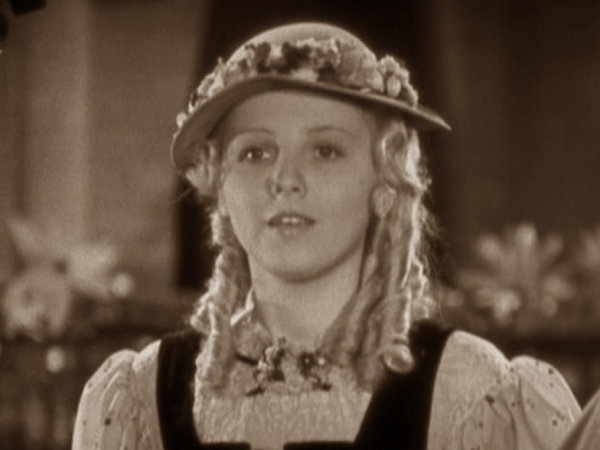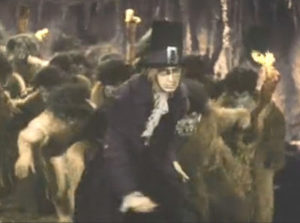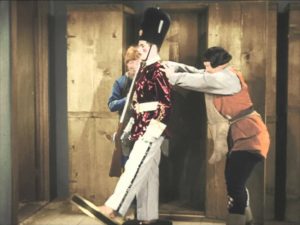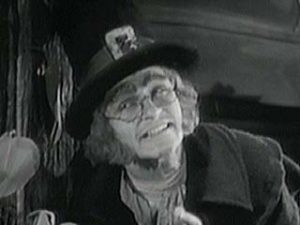Wooden Soldiers and Bogeymen as Racial Allegory
An interpretation of Hal Roach’s Babes in Toyland
by Hadding Scott
HAL ROACH’S 1934 film Babes in Toyland was later given the alternate title March of the Wooden Soldiers. Here, to avoid confusion with the 1903 operetta and 1904 children’s book of the same name (or the 1961 Disney film, which is slightly closer to the operetta), I will consistently use the alternate title to refer to Hal Roach’s film. There is, after all, good reason for not referring to these very different works by the same title.
March of the Wooden Soldiers is a 1934 film from Hal Roach’s production company, starring Stan Laurel and Oliver Hardy. It pretends to be based on the 1903 operetta Babes in Toyland by librettist Glen MacDonough and composer Victor Herbert. While Roach’s film includes some elements of the famous operetta, however, including some of the great music, it is a very different work, with different characters and a different story. I argue that what Hal Roach and his writers created is a racial allegory.
First, it is necessary to know what happens in the film.
Plot-Summary
After a fairly lengthy familiarization with what kinds of pleasant and innocent people inhabit Toyland, mostly characters from nursery-rhymes, the story begins with sinister old Silas Barnaby visiting the Old Woman in the Shoe to ask about the Old Woman’s nubile daughter, Little Bo-Peep, who has just gone out. Bushy-browed Barnaby locates Bo-Peep, a slender blonde beauty, and proposes marriage.
When Bo-Peep refuses, Barnaby becomes threatening and returns to Mother Peep demanding a mortgage-payment on the Shoe, which she is unable to make.
Stannie Dum and Ollie Dee live in an upstairs room of the Shoe. Ollie Dee has saved up some money that he will give to Mother Peep to keep up with the mortgage, but Stannie Dum has borrowed it to buy “peewees,” leaving an “IOU.”
Stannie Dum and Ollie Dee are workers in the Toy Factory. Ollie hopes to get the money for Mother Peep from the Master Toymaker, with whom he claims to be on good terms, but Stannie made a blunder that ruined any possibility of that. Santa Claus has ordered 600 toy soldiers 1 foot high, but Stannie garbled the order so that 100 soldiers 6 feet high were made. Santa Claus says, “I couldn’t give those things to my children to play with!” and the one toy-soldier that Stannie and Ollie have brought out for demonstration proceeds to make a wreck of the Toy Factory, making it impossible to ask the Master Toymaker for any favors.
Tom-Tom the Piper’s Son has proposed marriage to Little Bo-Peep and she has accepted, but Silas Barnaby will not be deterred. He returns to issue an ultimatum to Mother Peep: either Little Bo-Peep will marry him or Mother Peep and the other residents of the Shoe will be cast out onto the street.
After an attempt to solve Mother Peep’s problems by sneaking into Barnaby’s house, Stannie Dum and Ollie Dee are convicted of burglary and sentenced by Old King Cole to dunking, to be followed by banishment to Bogeyland. At this point Little Bo-Peep agrees to marry Silas Barnaby, with the result that he drops the charges against Stannie and Ollie.
Bo-Peep is given a way out of the marriage when Stannie, covered in a bridal veil, takes her place at the wedding, to be unveiled only after Barnaby hands over the mortgage on the Shoe. Ollie gets the mortgage in his hands and tears it up before Silas Barnaby detects the trick.
After this fortunate turn, Tom-Tom tells Bo-Peep that he will take her away, and sings “Castle in Spain.” But this is not the end of the film: there is nearly half an hour to go, enough time for Barnaby to attempt revenge. Like the Big Bad Wolf, Barnaby blows over Elmer the Pig’s house of straw and abducts him. Barnaby then has the pig’s hat and fiddle and some sausages planted in Tom-Tom’s house to frame him for “pignapping.” Old King Cole banishes Tom-Tom to Bogeyland.
Stannie and Ollie accidentally discover that the sausage used to frame Tom-Tom was beef, not pork, then find Elmer the Pig bound and gagged in Barnaby’s cellar, but Tom-Tom has already been carried away to Bogeyland. Barnaby flees as Old King Cole offers 50 thousand guineas for the scoundrel’s capture “dead or alive.”
Bo-Peep goes looking for Tom-Tom in Bogeyland and finds him. Then Barnaby finds the two of them sleeping in a cave and a struggle ensues. Barnaby summons his minions, the apelike Bogeymen, to help him capture Tom-Tom and Bo-Peep.
Stannie and Ollie, pursuing Barnaby, happen upon Tom-Tom and Bo-Peep, and, panicking at the site of the onrushing Bogeymen, flee with them back to Toyland, where, recounting their experience, they play the role of heroes.
Meanwhile Barnaby vows “to destroy the whole of Toyland” by leading the onslaught of the Bogeymen. The gates of Toyland are thrown open with Silas Barnaby at the head of a mob of furry brown men, who seem primarily occupied with getting into the dwellings where people are hiding and then carrying them away.
Stannie and Ollie fight the Bogeymen with darts, until Stannie gets the idea of activating the 100 six-foot-tall toy soldiers. The march of the soldiers out of the toy warehouse to the scene of battle is an awesome sight. The Bogeymen are no match for the Wooden Soldiers and are quickly defeated.
The Bogeymen at the end are pushed out the gate and into the moat, where they are eaten by crocodiles and the townspeople have a great laugh. Ollie then accidentally gets shot in the buttocks with a cannonload of darts.
Babes in Toyland vs. Oliver and Hardy in Toyland
Hal Roach’s 1934 film, although it begins with Mother Goose singing “Toyland” as she introduces characters from a book titled Babes in Toyland, tells an entirely different story from the one in the book, and really none of the characters are the same. Only certain elements from MacDonough’s Babes in Toyland are retained, and some of those retained elements are given a very different meaning.
Whereas MacDonough’s story wanders through several towns and other locales, the 1934 screenplay has only two locales: the charming walled city called Toyland where all the harmless nursery-rhyme characters live (with a villain among them), and on the other hand Bogeyland, a wilderness inhabited by Bogeymen. The Bogeymen play a key part in the 1934 production, insofar as the villain mobilizes them in an attack on Toyland (the main event in what I see as a racial allegory), whereas in the book neither Bogeyland nor Bogeymen exist, and no such attack occurs.
The differences between the villain of the 1934 production and the villain of the book are most important. For one thing, they have different names. The original villain was Uncle Barnaby, whereas the 1934 villain is Silas Barnaby. That is an important difference that relates to the different crimes of the two villains.
Uncle Barnaby’s intended victims were his nephew and niece, whom he wanted to kill so that he could steal their inheritance; MacDonough’s story revolves entirely around this intention of murder and larceny, and the children’s escape. Although the Uncle Barnaby of the book is a greedy usurer, and although he is said to wear a skullcap – considerations that might lead one to ask about his ethnicity – there is a barrier to interpreting Uncle Barnaby as Jewish, insofar as he is a blood-relative of the main characters, his intended victims, about whom there is nothing remotely Jewish. (The innocent niece and nephew, the main characters of the book, do not appear at all in Hal Roach’s film.)
By contrast, the Silas Barnaby of the 1934 production is nobody’s uncle, which leaves open the possibility of seeing him as a Jew. Indeed he seems to be a composite of negative Jewish stereotypes: he is the usurer, the shyster, the agitator. He has power and influence because of his money, but the central motive for Silas Barnaby has nothing to do with money: rather, he is trying to force the young, pure, idealistic blonde, Little Bo-Peep, to marry him. (That may not seem an especially Jewish motive but it can be taken as a metaphor for the Jewish demand of not being excluded from anything in Gentile society.) The way that Silas Barnaby attempts to force Little Bo-Peep to marry him also happens to anticipate in several respects (or perhaps inspired, given that the later film is not a strictly accurate history) the cinematic representation of Joseph Suess Oppenheimer in Veit Harlan’s Jud Süß (1940), where Little Bo- Peep is replaced by Dorothea Sturm.
A blogger named Mike King, who has clearly taken his cue from my original post on this topic from 24 December 2012, makes much of the fact that Barnaby’s assistant wears what looks like a yarmulke. By itself, it is hard to know how much to make of that, since the Master Toymaker also wears a skullcap (although different). The headwear of Barnaby’s assistant, however, gains significance from the fact that the wearer is also the only swarthy person and the only character with a foreign accent in the film. (“Foreign-born” used to be practically a euphemism for Jewish.) Although inconclusive in itself, all of this together can be taken as corroborative of the other evidence of Barnaby’s Jewishness.
Of course, unless it is recorded somewhere that one of them actually said so, it is impossible to prove absolutely that Hal Roach and his screenwriters, Frank Butler and Nick Grindé – or Stan Laurel, if his influence went that far – intended Silas Barnaby as a Jew. It is certain, however, that Silas Barnaby can be seen as a Jew. The gestalt implying the Jewishness of Silas Barnaby – at least three Jewish stereotypes in one character – is (for me at least) quite compelling.
Bogeymen of the Early 20th Century
Barring inspiration from some non-material realm, creatures of fantasy such as the Bogeymen must be derived from things that actually exist. It is not hard to think of a foundation in reality for the idea of Bogeymen. Ollie Dee tells Old King Cole that the Bogeymen are “half-man and half-animal”; the word Bogeymen already says that they are simultaneously men and not quite men, or a lower type of man.
When the torch-bearing throng of Bogeymen enters Toyland with Silas Barnaby at their head, the residents of Toyland flee into their houses. The Bogeymen rush through the streets and begin climbing on the houses, looking for ways to break in. Torches in the Bogeymen’s hands imply arson, but that possibility is never actualized because it would put a blemish on the eventual happy ending. Arson is not the only likely outcome that is omitted. We see a Bogeyman seizing a screaming young woman, and several Bogeyman carrying off children, but of course no one’s clothes are torn or removed. Silas Barnaby himself is in the act of abducting his own unwilling bride when the Wooden Soldiers arrive to reestablish order and civilization. In this film for general audiences, of course the real horror of what Silas Barnaby and the Bogeymen represent is only implied. What is implied matches what we know happens when Blacks become lawless.
The White world had experienced numerous bloody Negro insurrections in the 19th and early 20th centuries.
Outbursts of Black mass-violence against Whites continued long after slavery was abolished. In the early 20th century there was a Negro uprising in Cuba staged by the Partido Independiente de Color that developed into the Cuban Race War of 1912, which was accompanied by rape, murder, and “unspeakable outrages” against White women (Crawfordsville Review, 6 June 1912). Order was reestablished only after the United States sent in marines and bluejackets.
In 1915 D.W. Griffith’s Birth of a Nation, one of the most influential films of all time, represented the Negro takeover and accompanying abuses after the War of Southern Independence. These troubles, as represented in the film, were caused fundamentally by a White congressman of perverse will named Stoneman, and his mulatto protégé Silas Lynch. In the finale, the Negroes’ rampage is suppressed by the arrival of the Ku Klux Klan on horseback.
In 1917, the bloody Bolshevik takeover in Russia cast a long shadow over the first half of the 20th century. Lothrop Stoddard’s 1922 book, The Revolt Against Civilization: The Menace of the Underman, explained this event as the result of a proliferation of congenital misfits and throwbacks, which he called “the underman.”
In the 1920s Lothrop Stoddard added scholarly respectability to the proposition that the White race must act to preserve itself against the encroachment and aggression of non-White races. Stoddard’s influence was such that his book The Rising Tide of Color against White World Supremacy (1920) was even mentioned in a 1921 speech given by President Warren G. Harding in Birmingham, Alabama. That book attracted attention again in 1933 because of concerns about the expansion of Imperial Japan, about which Stoddard had been prescient.
Stoddard’s warnings focused mainly on the human material for revolution, not so much on the instigators. Not infrequently, behind the Negro insurrections of the 19th century there stood an instigator or inspirator who was himself not a Negro but a White man obsessed with Biblical morality, John Brown being the most famous example. In the 20th century, however, agitation of the Negro and of the “underman” against the majority was largely taken over by Jews pursuing power for their ethnic group.
The Great Depression, which had begun in 1929, created favorable conditions for a revolutionary movement – notoriously led by Jews (e.g., at that time Herbert Benjamin, Israel Amter, Mike Gold) in the USA as it had been in Russia – to recruit new members with the intention of eventually bringing Bolshevism to the United States. They were especially successful in recruiting Negroes.
Thus, when March of the Wooden Soldiers appeared in 1934, bloody insurrections by Negroes and other lower humanity were a matter of living memory and of present concern, and there was widespread awareness of the role of Jews as instigators. Meanwhile, the vision of a violent Negro rampage suppressed by an armed force of White men constituted the finale of the greatest motion picture yet created.
In fact, Babes in Toyland can be seen as in some ways the same story as Birth of a Nation, with Bogeymen in the place of Blacks and wooden soldiers in the place of Klansmen, and Silas Barnaby playing a role somewhat analogous to that of Congressman Stoneman and Silas Lynch. In that light, the copying of the name Silas from Birth of a Nation, where Silas was the mulatto who transgressed with his intention to marry a White woman, seems to be a hint about how the villain of Babes in Toylandis to be understood. In other words, Silas Barnaby is transgressing against a racial barrier when he seeks to marry Bo-Peep – because he is a Jew.
Hal Roach’s Differences with Jews
The producer is the idea-man behind the movie. Hollywood producer Hal Roach was an Irish American who, after starting as an actor in Hollywood, was able to start his own production-company because of an inheritance. His best-known productions are the Our Gang shorts, and films featuring Stan Laurel and Oliver Hardy.
One of Hal Roach’s silent productions in 1927 was a short called Jewish Prudence, written by Stan Laurel and starring Jewish character-actor Max Davidson. It portrays Jews in a thoroughly stereotypical manner that must inevitably have a cautionary effect. It shows Jews for example as swindlers. Of course this does not mean that Hal Roach categorically disliked all Jews, but it suggests that for him Jews as a group were no object of reverence.

It may also be significant that Stan Laurel, the writer of Jewish Prudence, is said by various sources to have exerted considerable influence over how March of the Wooden Soldiers turned out (e.g., Danny Lawrence, The Making of Stan Laurel, 2011, p. 82, writes that Roach “yielded to Stan on the creative side of the production”).
In 1937, three years after March of the Wooden Soldiers, Hal Roach formed the RAM (Roach And Mussolini) production company, with Vittorio Mussolini, the 20-year-old son of the Italian Duce. The company started with capital from the Banca Nazionale del Lavoro (a subsidiary of the Italian government at that time) and from Roach himself. Once the deal was sealed, Roach met the Duce, a great fan of motion-pictures who hoped that Hal Roach would bring Italian productions up to the Hollywood standard. Perhaps it was March of the Wooden Soldiersthat had particularly impressed the Italian leader!
When Roach came under attack for this deal, he made no bones about the fact that the trouble was coming from Jews. To the Jews, Roach gave a half-pleading, half-scolding response, recorded in Sheilah Graham’s “Hollywood Today” column:
“Mussolini has never expressed himself against the Jews,” said Roach. “As a matter of fact, Italy is full of non-Aryans driven out of Germany by Hitler. But if one day Mussolini adopted Hitler’s racial policy, a man close to him could be of great use. I’m convinced that my association with Mussolini is the finest thing that could have happened for the Jews. If they’re smart, they’ll stop antagonizing Mussolini by showing bad feeling toward his son.” [Sheilah Graham, 5 October 1937]
When Vittorio Mussolini visited the United States in 1937, he first had to avoid Communist protestors in New York City (AP, 24 September 1937), then was under heavy police protection during his 20 minute layover in Kansas City (AP, 25 September 1937), then had his presence “deplored” in paid advertisements by Hollywood’s “Anti-Nazi League for the Defense of American Democracy” (AP, 25 September 1937). With a candor that would later become quite rare, The Day, a newspaper in New London, Connecticut, stated unequivocally that the troubles befalling Roach And Mussolini were due to the prevalence of Jews in Hollywood:
Moreover, considering the large number of Jews in executive, directorial and screen acting parts, in Hollywood, it was not surprising to find a fairly well established antagonism toward Mussolini’s son in the colony. Il Duce is the father of Fascism; in many matters he is supposed to be working hand and glove with Hitler. Hitler has persecuted the Jews, and the members of this race in Hollywood think it not unreasonable to hold that Mussolini is at least indirectly connected with the troubles that have beset their people.
When the Hal Roach studios arranged a testimonial dinner for young Mussolini, before he hurriedly left the movie center, more than half of the 300 invited guests failed to appear…. [“Snub to Young Mussolini”,The Day, New London, Conn., 2 November 1937]
One author describes the demise of Roach And Mussolini as having been forced on Roach by the company that distributed his films:
“The industry as a whole let Roach know, but fast, that they weren’t happy,” said Roach special effects man Roy Seawright. “But Roach could be stubborn; he used to be a truck driver and he ran his business the way he did a truck He saw a road to take, and he was going to go down that road come hell or high water.”
The upshot of all this was that an appalled Nick Schenck pulled Loew’s distribution out from under Roach. His last MGM release was the Laurel and Hardy feature Blockheads, after which, in May of 1938, he began releasing through United Artists….
Roach had no apparent regrets; as an old man living in Beverly Hills, one of the prominent features of his house was a warmly autographed portrait of Benito Mussolini. [Scott Eyman, Lion of Hollywood: The Life and Legend of Louis B. Mayer, 2008]
Incidentally, the highly conditional nature of the Hollywood Jews’ opposition to Fascism is evident in the fact that four years prior to the short life of Roach And Mussolini, Jack Cohn, a vice-president of Columbia Pictures, had made the encomiastic documentary Mussolini Speaks, and was thereafter invited to visit the flattered Duce (“From the Studios”, Lewiston Daily Sun,6 February 1933). The difference is that in the years between Jack Cohn’s Mussolini Speaks and Hal Roach’s deal with Vittorio Mussolini, a positive relationship developed between Italy and National-Socialist Germany, which was seen as contrary to Jewish interests. This consideration of Jewish interests made all the difference in whether it was acceptable for anyone in Hollywood to do business with Fascist Italy, and whether Fascist Italy must be portrayed positively or negatively.
Thus, Hal Roach backed out of the deal with Mussolini because Jews forced him and he could not do otherwise.
It is apparent that Hal Roach’s political and social outlook was different from and somewhat opposed to that of Jewish Hollywood. It does not seem unlikely that Hal Roach would have made a film with implied negative messages about Jews such as I believe March of the Wooden Soldiers to be, especially since his studio had already made at least one short film with overt negative messages about Jews in 1927.
* * *
Source: National-Socialist Worldview











Nice review, Hadding. Could Irish-American Roach be deliberately “shooting the bird” in the photo of him in your piece? I’d like to think he was. He wouldn’t have been the first or the last to do so.
To go off topic a bit, here is an interesting piece about flashing the metacarpophalangeal joint by others through history: https://www.theatlantic.com/culture/archive/2013/09/middle-finger-brief-history/311205/
While it is entertaining to read about history with hitherto hidden meanings and agendas, it should not distract from the real business of stocking up on essentials and networking amongst kinsmen.
Within this context, it should be noted that
many American Caucasians fled the so-called
“Great Depression” and moved to Soviet
Russia seeking relief. Ultimately they were
interred into labor camps and worked to death
in Bolshevik “people’s projects.” Even down
to this day, not a word of this is heard in USofA
controlled mass media.